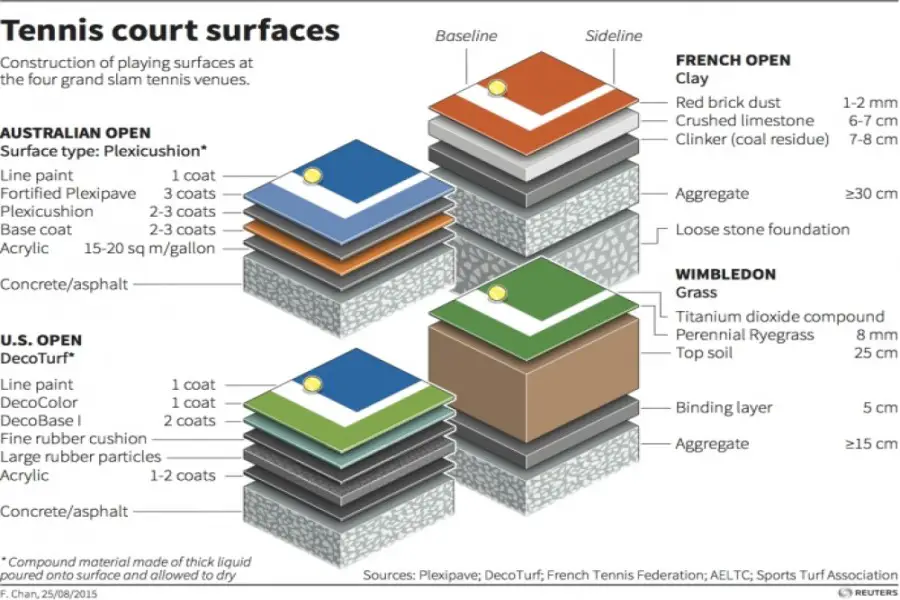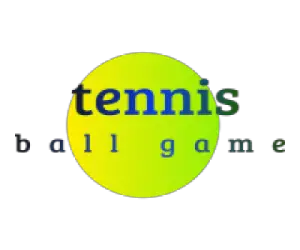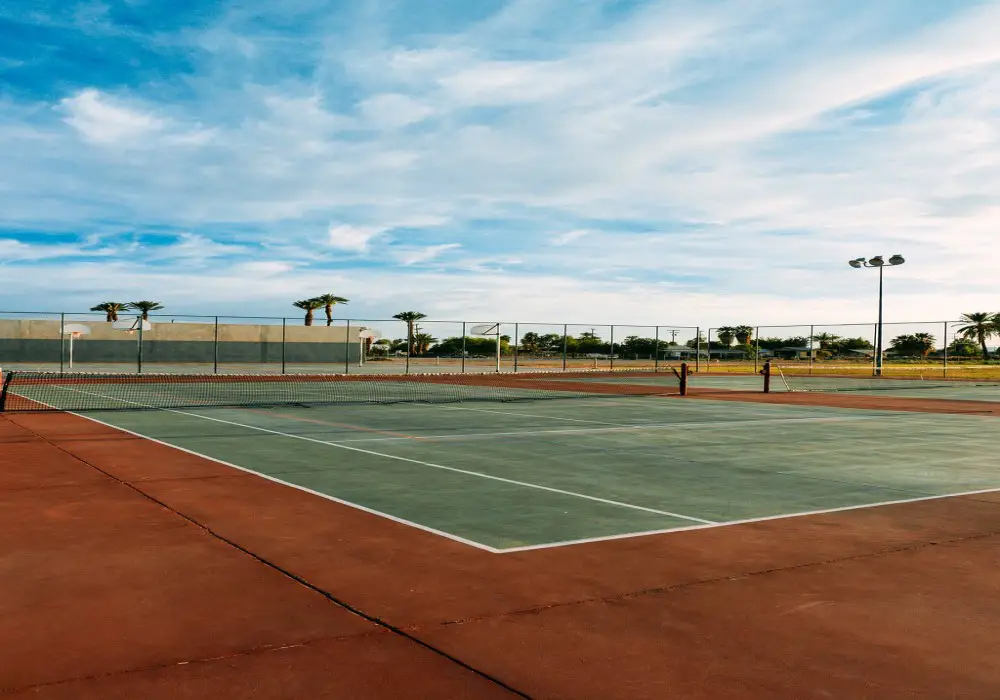Get the low tennis court definition including which type of slow tennis court is used at major tennis games at international level.
There are so many types of tennis courts some of which are referred to as slow courts and others as fast courts. Understanding the key factors contributing to the varying tennis court speed is important.
A slow tennis court is a court that significantly reduces the overall speed of a tennis ball. Bouncing a tennis ball in a slow court reduced the speed of movement but a ball bounces higher. Since a tennis ball moves slowly in a slow court, the game tends to last longer.
In tennis, tennis courts can either be a slow court or a fast court. Slow courts tend to make the ball bounce higher but move slowly. On the other hand, fast courts tends to make the ball move faster but at a much lower bounce height.
All tennis courts have the capabilities of being slow or fast depending on several factors. All tennis courts are designed to meet International Tennis Federation Guidelines.
The commonly used tennis court surface material in the construction of a tennis court include:
- Polyurethane/Acrylic
- Artificial grass/grass
- Artificial clay/Hybrid clay/clay
- Carpet
- Asphalt
- Concrete
- Tiles
- Wood
- Canvas
3 Main Types of Tennis Courts At International Level
However, at international levels, the 3 main types of tennis courts include:
1. Clay Courts
Clay courts often colored red is popularly used in the French Open tournaments. The following are the characteristics of clay courts:
- Tennis ball movement is the slowest
- Overall ball skid is significantly reduced
- Balls have a high bounce height
2. Grass Courts
Grass courts can be made of natural or artificial grass. Wimbledon championships official tennis court is grass courts. The following are the characteristics of grass court surfaces in tennis:
- Fastest tennis ball speeds since the surface is highly slippery
- Reduced ball bounce due to impact of soil beneath
- Ball bounce characteristics such as directions is unpredictable
- Lower ball bounce
3. Hard Courts
Commonly used materials in the construction of hard court tennis include concrete or asphalt. Hard courts are the US Open official tennis court. The hard court surfaces characteristics include:
- Easy to maintain in the long run
- Ball speed is slower compared to grass court but faster when compared to clay court.
- Due to hard courts being flat and even, ball bounce direction can be predictable

Slow Tennis Courts In Major Tournament
Both slow and fast tennis courts are used in major tournaments such as Grand Slam. The table below shows 2020 courts and ball type used.
| Grand Slam Tournament | Type Of Tennis Court Surface | Court Speed | Ball Used |
| Australian Open | Australian Open GreenSet | Medium-Fast Category 4 | Dunlop |
| French Open | Red Clay | Slow Category 1 | Wilson |
| Wimbledon | 100% Perennial Ryegrass | N/A | Slazenger |
| US Open | Laykold Cushion Plus System | Medium-Slow Category 2 | Wilson |
Factors Contributing To A Slow Tennis Court
Tennis court speed can be slow, medium and fast. The lowest speed tennis court is the clay court. The fastest tennis court speed is achieved in the grass courts.
If you are wondering why are tennis slowed down, it is mainly because of factors such as court construction material and environmental factors such as wind, and temperature. All these courts have a standard tennis court dimensions. Tennis court measurement has to meet the International Tennis Federation standards.
To have a better understanding, the slowing factors of the major types of tennis court surfaces as been discussed.
Clay Courts Slowing Factors
A number of factors contribute to the slow speed of movement of a tennis ball in a clay court. Nadal, the King of Clay, seems to have mastered and maximize all this factors to his advantage. The slowing factors include:
1. Clay Particles
As a tennis ball hits the clay some of its kinetic energy, energy in motion, is lost to hitting and crushing some of the clay particles. As a result, the overall speed is reduced.
Besides, the overall joining of the clay particles to each other increases the frictional force the ball will encounter once it hits the tennis court. That is why thicker top clay layers tend to significantly reduce a ball speed compared to a less thick clay layers. The ultimate ball speed then reduces.
2. Crushed Stone Layers
Clay courts is made of several layers and below the top clay layers are layers of crushed stones and limestone. These crushed stones contribute to the high bounce of a tennis ball. In fact, the bounce on a clay court is much higher than the bounce in hard courts.
Grass Courts Slowing Factors
Roger Federer, the King of grass courts, appears to take advantage of these slowing factors tow in a game. Grass courts can sometimes be slowed down as a result of the following factors:
a. Soil Compactness
Grass if often put on a layer of soil. As a result, as there is increased stepping on the grass by players the soil underneath becomes compacted. As the soil compactness increases the speed of the ball is enhanced.
Thus, at the start of the game in a new grass tennis court the speed would be much slower but as the game progresses the speed increases since the ground becomes compact.
b. Uniformity Of Grass
A more uniform grass tend to reduce the bounce od a ball and even the speed of the movement of the ball. Perhaps the bounce of the ball could be reduced due to more cushioning effect by the uniformed grass.
That is why at the beginning of a game played in a grass court a tennis ball tends to move much slower in the court since the grass is still new and has much cushioning effect on the ball.
However, as the game progresses the grass wears off over time as its being trampled on by the players running and walking all over and also the bounce of the ball.
In the end, the resultant ununiformed grass cover does not offer more cushioning to the ball and the ball speed can be observed to be increasing.
Hard Courts Slowing Factors
There are several factors that result in slowing down the overall speed of movement of a tennis ball in a hard court. The slowing factors include:
Layers
The materials of construction of the layers used in making a court can also affect the speed of movement of tennis balls.
For instance, when a plexicushion layers is placed beneath the top layer of a tennis court as don in Australian Open courts, a ball tends to lose its speed as soon as it bounces on the court due to the cushioning effect of plexicushion material.
Due to lack of cushioning in the hard courts such as the US Open courts, the ball moves faster.
Silica
The silica content used in the overall construction of a tennis court is a great contributor to slowing down a tennis ball. The higher the silica content, the more a tennis court becomes granular or perhaps rough.
As a result, friction increases that would ultimately reduce the speed of horizontal movement of a tennis ball.
It is likely to see that during a tournament using a hard court, at the start of the game when the court is still new and more granular tennis ball moves more slowly.
However, towards the end of the game the ball tends to move faster since the surface has been eroded and there is minimal friction to hinder a fast horizontal movement of the ball.
Type Of Tennis Balls
International Tennis Federation has outlined specific standard guidelines for manufacturer’s to use in producing tennis balls. Even though the differences being small, tennis ball type have been greatly linked to slow movement in courts.
For instance, Type 1 tennis balls moves at greater speeds through air. On the contrary, Type 3 tennis balls tends to move much slower through air.
In addition, the more fluffy a ball is the slower it moves through air due to the ball experiencing much resistance during movement compared to a less fluffy tennis ball.
Atmospheric Pressure
At high altitudes, air pressure is low, and the air density is also low. So, the tennis ball can experience minimal resistance of movement compared to a low atmospheric region.
Wind
When a tennis ball moves against the wind directly, the ultimate speed of the ball can be reduced. Furthermore, strong winds have the potential to alter the intended direction of a tennis ball and could affect the overall tennis play.
Temperature
Air temperature during which a tournament is played can significantly affect the speed of movement of a tennis ball. When the temperatures are low, air density is high and result in high resistance to a moving ball. The ball speed reduced.
The opposite is true for a high temperature tournament day. The tennis ball tends to move faster through the less dense air.
Tennis Players
Yes. The speed at which the tennis players serve and return a ball affects the overall speed of the game. Besides, a player’s technique can also slow down a tennis ball.
For instance, Nadal uses one of his tennis ball left-handed strategy of spinning the ball to reduce its speed of movement and confuse his opponents.
Conclusion
Tennis court speeds is mainly contributed by a tennis court material as well other environmental factors such as wind. However, despite the varying tennis characteristics a few outstanding tennis players have dominated some tennis courts. Federer has won many titles in the grass courts and he is the king of grass courts. On the other hand, Nadal is the king of the clay courts. Despite the varying ball speeds in a court, you can still win a competition.
Related Articles
Who Has Won All 4 Grand Slams In The Same Year?
How Long Do Tennis Balls Last?


